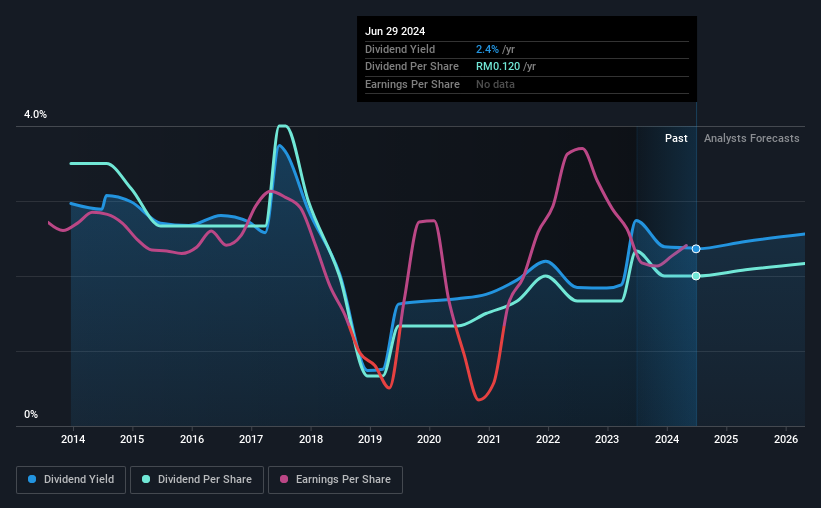United Malacca Berhad (KLSE:UMCCA) Will Pay A Dividend Of MYR0.07
United Malacca Berhad (KLSE:UMCCA) has announced that it will pay a dividend of MYR0.07 per share on the 9th of August. This payment means that the dividend yield will be 2.4%, which is around the industry average.
View our latest analysis for United Malacca Berhad
United Malacca Berhad's Dividend Is Well Covered By Earnings
We aren't too impressed by dividend yields unless they can be sustained over time. The last dividend was quite easily covered by United Malacca Berhad's earnings. This means that a large portion of its earnings are being retained to grow the business.
Looking forward, earnings per share is forecast to rise by 68.9% over the next year. Assuming the dividend continues along recent trends, we think the payout ratio could be 27% by next year, which is in a pretty sustainable range.
Dividend Volatility
The company's dividend history has been marked by instability, with at least one cut in the last 10 years. Since 2014, the dividend has gone from MYR0.21 total annually to MYR0.12. The dividend has shrunk at around 5.4% a year during that period. Generally, we don't like to see a dividend that has been declining over time as this can degrade shareholders' returns and indicate that the company may be running into problems.
The Dividend Looks Likely To Grow
Dividends have been going in the wrong direction, so we definitely want to see a different trend in the earnings per share. United Malacca Berhad has impressed us by growing EPS at 27% per year over the past five years. The company doesn't have any problems growing, despite returning a lot of capital to shareholders, which is a very nice combination for a dividend stock to have.
United Malacca Berhad Looks Like A Great Dividend Stock
Overall, we think that this is a great income investment, and we think that maintaining the dividend this year may have been a conservative choice. Distributions are quite easily covered by earnings, which are also being converted to cash flows. All in all, this checks a lot of the boxes we look for when choosing an income stock.
Companies possessing a stable dividend policy will likely enjoy greater investor interest than those suffering from a more inconsistent approach. Still, investors need to consider a host of other factors, apart from dividend payments, when analysing a company. Taking the debate a bit further, we've identified 1 warning sign for United Malacca Berhad that investors need to be conscious of moving forward. Looking for more high-yielding dividend ideas? Try our collection of strong dividend payers.
Have feedback on this article? Concerned about the content? Get in touch with us directly. Alternatively, email editorial-team (at) simplywallst.com.
This article by Simply Wall St is general in nature. We provide commentary based on historical data and analyst forecasts only using an unbiased methodology and our articles are not intended to be financial advice. It does not constitute a recommendation to buy or sell any stock, and does not take account of your objectives, or your financial situation. We aim to bring you long-term focused analysis driven by fundamental data. Note that our analysis may not factor in the latest price-sensitive company announcements or qualitative material. Simply Wall St has no position in any stocks mentioned.
Have feedback on this article? Concerned about the content? Get in touch with us directly. Alternatively, email editorial-team@simplywallst.com

 Yahoo Finance
Yahoo Finance 